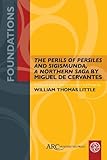"The Perils of Persiles and Sigismunda, a Northern Saga" by Miguel de Cervantes / ed. by William Thomas Little.
Material type: TextSeries: ARC - FoundationsPublisher: Leeds : ARC Humanities Press, [2023]Copyright date: ©2023Description: 1 online resource (473 p.)Content type:
TextSeries: ARC - FoundationsPublisher: Leeds : ARC Humanities Press, [2023]Copyright date: ©2023Description: 1 online resource (473 p.)Content type: - 9781802701555
- 863.3
- PQ6327.P4
- online - DeGruyter
| Item type | Current library | Call number | URL | Status | Notes | Barcode | |
|---|---|---|---|---|---|---|---|
 eBook
eBook
|
Biblioteca "Angelicum" Pont. Univ. S.Tommaso d'Aquino Nuvola online | online - DeGruyter (Browse shelf(Opens below)) | Online access | Not for loan (Accesso limitato) | Accesso per gli utenti autorizzati / Access for authorized users | (dgr)9781802701555 |
Frontmatter -- CONTENTS -- List of Illustrations -- Abbreviations -- Acknowledgements -- Introduction -- THE PERILS OF PERSILES AND SIGISMUNDA, A NORTHERN SAGA -- First edition preliminary documents -- Title page 1617 -- Pricing statement -- Certificate of errata -- The King’s approval -- The Censor’s approval -- Poem -- Poem -- Dedication by Cervantes to Pedro Fernández de Castro -- Prologue -- First Book of the Story of the Perils of Persiles and Sigismunda -- Second Book of the Perils of Persiles and Sigismunda -- Third Book of the Perils of Persiles and Sigismunda, A Northern Saga -- Fourth Book of the Perils of Persiles and Sigismunda, A Northern Saga -- List of Characters -- Select Bibliography
restricted access online access with authorization star
http://purl.org/coar/access_right/c_16ec
Los trabajos de Persiles y Sigismunda, historia septentrional (1617) is Miguel de Cervantes’s last major work. Virtually ignored for the past four hundred years and overshadowed by the acclaim accorded Don Quixote, it is due a revival. As indicated by this new English title, The Perils of Persiles and Sigismunda, a Northern Saga, this challenging saga-like fiction follows an attractive young prince and princess who undertake a perilous pilgrimage by sea and on land from their North Atlantic islands to Rome. This new translation by William Thomas Little takes full account of recent scholars’ ground-breaking research and their new readings. It also includes a selected bibliography, a contextualizing introduction, and footnotes on the text that clarify for contemporary readers cultural issues that were readily known to seventeenth-century readers in Spain, France, Italy, Portugal, and England.
Mode of access: Internet via World Wide Web.
In English.
Description based on online resource; title from PDF title page (publisher's Web site, viewed 02. Jun 2024)


